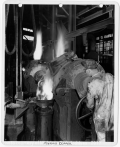
Calumet & Hecla - White Pine Mill |
Metal Trade, Copper Industry and Trade, Copper Mines and Mining, Buildings, Manufacturing Process, Mills and Millwork |
White Pine Mill Progress Photo - White Pine Mill Wash
Scanned: September 25, 2009 |
|

Calumet & Hecla - White Pine Mill |
Metal Trade, Copper Industry and Trade, Copper Mines and Mining, Seasons, Winter, Manufacturing Process, Mills and Millwork |
White Pine Mill Progress Photo - View of Stamp Mill and C.P. looking N. W.
Scanned: September 25, 2009 |
|

Calumet & Hecla - White Pine Mill |
Metal Trade, Copper Industry and Trade, Copper Mines and Mining, Buildings, Manufacturing Process, Mills and Millwork |
White Pine Mill Progress Photo - White Pine Mill Wash
Scanned: September 25, 2009 |
|

Calumet & Hecla - White Pine Mill |
Metal Trade, Copper Industry and Trade, Copper Mines and Mining, Manpower, Labor, Manufacturing Process, Mills and Millwork |
White Pine Mill Progress Photo - White Pine Mill Boiler House
Scanned: September 25, 2009 |
|

Calumet & Hecla - Wolverine Tube Division |
Metal Trade, Copper Industry and Trade, Buildings, |
[General offices of Wolverine Tube in Detroit]
Scanned: September 28, 2009 |
|

Calumet & Hecla - Wolverine Tube Division |
Metal Trade, Copper Industry and Trade, Miners, Copper Miners, |
Shaft made at one of the Calumet and Hecla mines in the Upper Peninsula. In this photo you see the miners preparing to descend underground. [No indication of which mine this is was mentioned in the pictorial description.]
Scanned: September 28, 2009 |
|

Calumet & Hecla - Wolverine Tube Division |
Metal Trade, Copper Industry and Trade, Miners, Copper Miners, |
Car loaded with men descending one of the shafts which goes down on a rather steep incline. [Name and location of mine is not mentioned in pictorial description.]
Scanned: September 28, 2009 |
|

Calumet & Hecla - Wolverine Tube Division |
Metal Trade, Copper Industry and Trade, Miners, Copper Miners, |
Image of timber bracing in the stopes. As the ore body is removed the overhanging rock must be supported to prevent a cave in. This is done by means of timber bracings. After ore has been brought to the surface and processed through a concentrating plant to remove the non-metallics, it is fire-refined and cast into ingot form, cake form, or billet form. [Two miners inspect the bracing. Name and location of mine unknown.]
Scanned: September 29, 2009 |
|

Calumet & Hecla - Wolverine Tube Division |
Metal Trade, Copper Industry and Trade, Manufacturing Process, Manpower, Labor, Skilled Labor |
Pouring Copper. One of the oil fired furnaces used in the casting of round copper billets. Rigorous control of the temperature of the molten metal is necessary to insure a billet which is sound and free from porosity. The metal is being poured therough a cone known as a runner box, which is guided into place over the center of the mold by the operator at the lower left. The furnace operator at the right is handling a control which tilts the furnace and permits the metal to run into the vertical mold.
Scanned: September 28, 2009 |
|

Calumet & Hecla - Wolverine Tube Division |
Metal Trade, Copper Industry and Trade, Manufacturing Process, Manpower, Labor, Skilled Labor |
This process shows pouring a series of nine round billets. The man on the right is watching the flow of molten metal through colored goggles and holds a rod in his hand which is used to "feel" the metal as it rises in the mold so he can signal the other operator to bring the furnace back to its melting position and shut off the flow. Previous to casting, phosphorus is added to the molten mass in the furnace to combine with any free oxygen, thus deoxidizing the metal. The furnace charge is then covered with charcoal to protect the metal against further oxidation. Prior to pouring molten metal into a mold, the surface of the mold is coated with a specially developed mold dressing.
Scanned: September 28, 2009 |
|